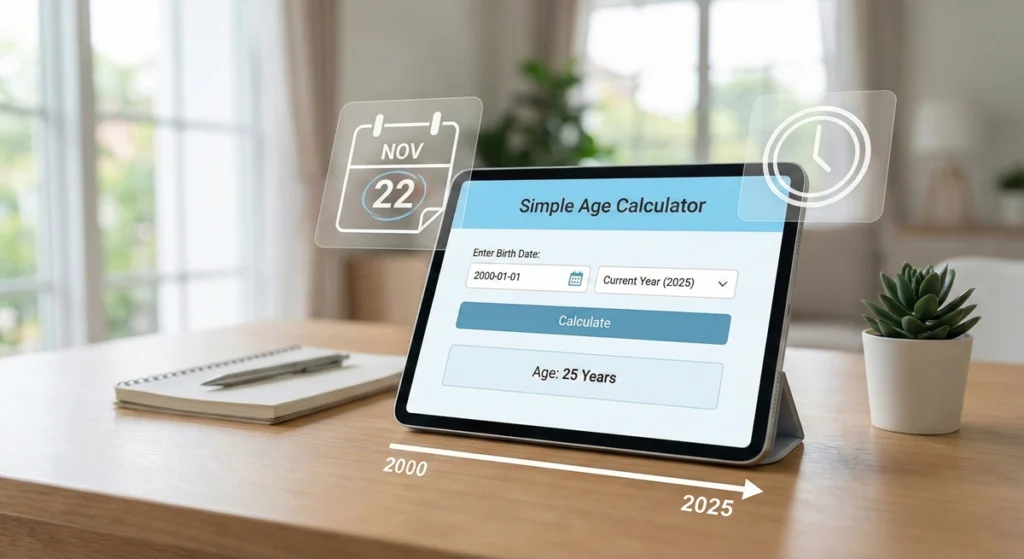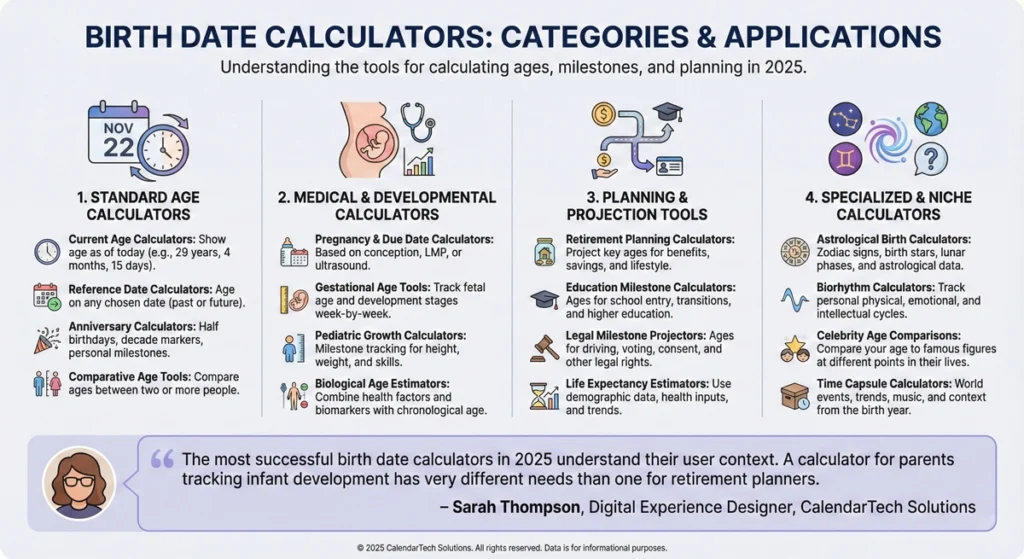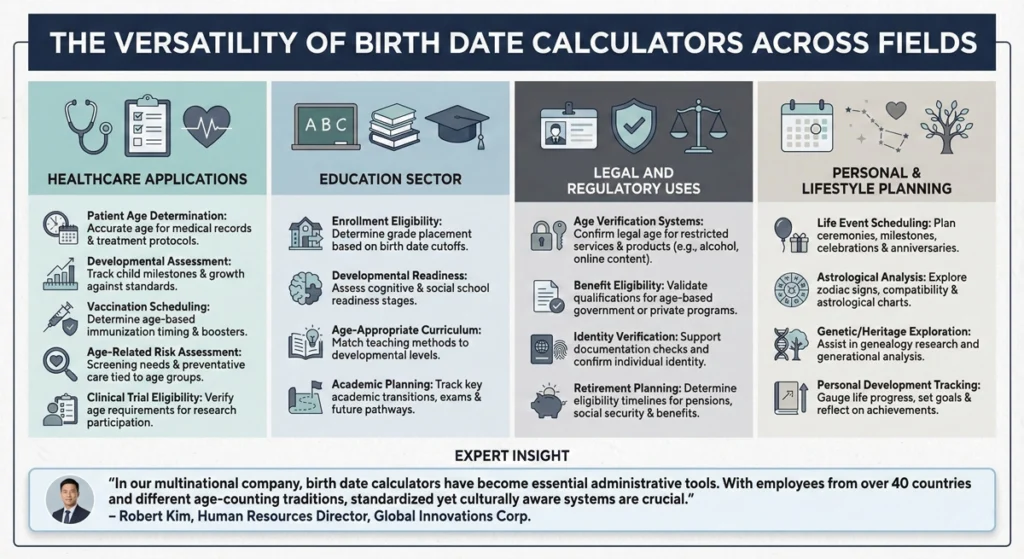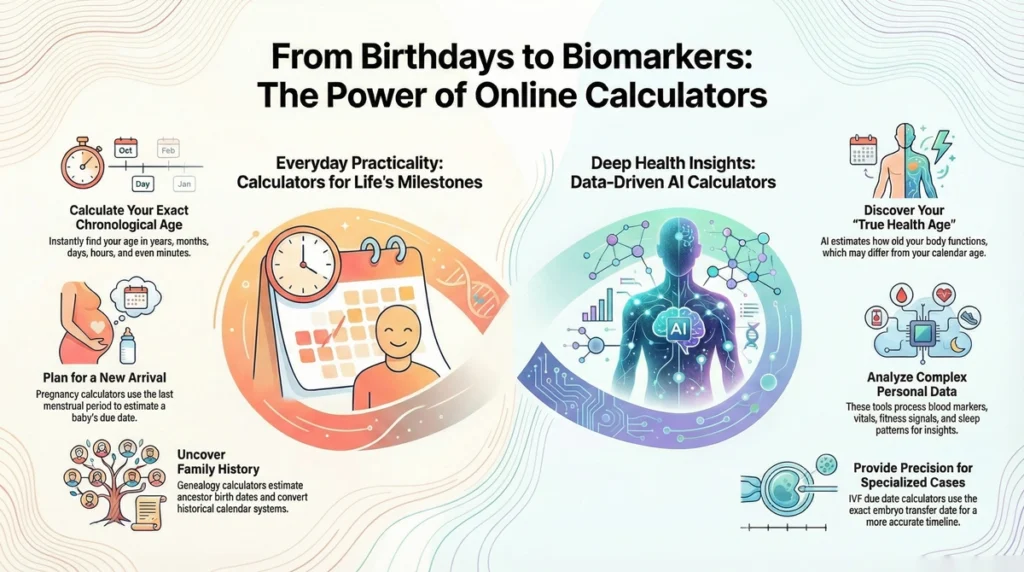In an increasingly digital world where personal information management and life planning have become more sophisticated, birth date calculators have evolved from simple age computation tools to comprehensive date intelligence systems. Whether you’re planning important events, verifying age-related eligibility, tracking developmental milestones, or conducting genealogical research, a reliable birth date calculator serves as an essential tool in both personal and professional contexts. As we navigate through 2025, these calculators have transformed significantly, incorporating advanced features that extend far beyond basic date arithmetic.
This comprehensive guide explores everything you need to know about birth date calculators—from fundamental concepts and calculation methodologies to sophisticated applications and emerging trends. We’ll examine how these versatile tools can enhance your planning capabilities, simplify complex date calculations, and provide valuable insights across various life scenarios.
- Understanding Birth Date Calculators: The Fundamentals
- The Mathematics Behind Birth Date Calculations
- Types of Birth Date Calculators and Their Applications
- Key Features of Modern Birth Date Calculators in 2025
- Applications of Birth Date Calculators Across Different Sectors
- How to Choose the Right Birth Date Calculator
- Implementing Birth Date Calculators: Best Practices
- Common Challenges and Solutions in Birth Date Calculation
- Future Trends in Birth Date Calculation Technology
- Educational Applications of Birth Date Calculators
- Ethical Considerations in Birth Date Calculation
Understanding Birth Date Calculators: The Fundamentals

Before delving into advanced applications, it’s essential to understand what birth date calculators are and the core functions they serve in our daily lives.
What Is a Birth Date Calculator?
A birth date calculator is a specialized tool designed to perform various computations based on a person’s date of birth. At its most basic level, it determines a person’s precise age by calculating the time elapsed between their birth date and the current date (or another specified reference date). However, modern birth date calculators offer significantly expanded functionality, including age projection, milestone planning, compatibility analysis, and various specialized calculations related to personal timelines.
Professor Elena Rodriguez, Digital Chronology Researcher at Stanford University, explains: “Today’s birth date calculators represent much more than simple subtraction between dates. They’ve evolved into sophisticated temporal intelligence systems that account for calendar complexities like leap years, time zones, and even cultural date conventions, while providing contextual insights relevant to different life stages and planning needs.”
The Evolution of Birth Date Calculation
Birth date calculation methods have transformed significantly throughout history:
Traditional Counting Methods: For centuries, cultures worldwide used various systems to track age, often marking years passed since birth with different celebrations or rites of passage.
Paper-Based Tools: Calendars, almanacs, and specialized charts emerged as early tools to systematize age calculation.
Early Digital Calculators: Simple electronic calculators and early computer programs introduced automated age computation in the late 20th century.
Web-Based Solutions: The internet brought accessible online calculators that could instantly process date calculations from any device.
Mobile Applications: Smartphone technology enabled portable, feature-rich birth date calculators with enhanced functionality.
AI-Enhanced Systems: In 2025, artificial intelligence has transformed these tools into predictive systems that not only calculate dates but provide personalized insights and recommendations.
The Mathematics Behind Birth Date Calculations
Understanding the computational foundations of birth date calculators helps users interpret results more effectively and select appropriate tools for specific needs.
Basic Age Calculation Formula
The fundamental calculation performed by birth date calculators is:
Age = Current Date – Birth Date
However, this simple subtraction becomes more complex when accounting for:
Calendar Variations: Different month lengths, leap years, and calendar systems.
Precision Requirements: Whether age is needed in years, months, days, or even hours and minutes.
Partial Years: How to represent age when someone is, for example, 25 years and 7 months old.
Reference Date Flexibility: Calculating age as of dates other than today (past or future points).
Michael Chen, Software Engineer at Chronos Technologies, explains: “The challenge in birth date calculation isn’t just mathematical—it’s handling edge cases elegantly. Consider someone born on February 29th during a leap year. In non-leap years, should their birthday be considered February 28th or March 1st for calculation purposes? Different calculators may implement different conventions, which is why understanding the underlying logic is important.”
Advanced Calculation Methodologies
Modern birth date calculators employ sophisticated algorithms to handle various scenarios:
Age in Multiple Units: Simultaneous calculation of age in years, months, weeks, days, hours, and minutes.
Milestone Projections: Forward calculation to determine dates when specific ages will be reached.
Date Difference Analysis: Precise measurement of time periods between arbitrary dates, not just involving birth dates.
Cultural Age Systems: Support for alternative age counting methods such as the traditional Korean or Chinese age reckoning systems, which calculate age differently than the conventional Western approach.
Astronomical Calendar Integration: Some specialized calculators incorporate lunar calendars or other astronomical systems for specialized applications.
Types of Birth Date Calculators and Their Applications

Several categories of birth date calculators have emerged to serve different needs and contexts.
Standard Age Calculators
Focusing on basic age determination:
Current Age Calculators: Compute exact age as of the present date.
Reference Date Calculators: Determine age as of any specified past or future date.
Anniversary Calculators: Track important milestones like “half birthdays” or decade markers.
Comparative Age Tools: Calculate age differences between two individuals.
Medical and Developmental Calculators
Specialized for health and growth assessment:
Pregnancy and Due Date Calculators: Determine expected delivery dates based on conception or last menstrual period.
Gestational Age Tools: Calculate fetal age and development stage during pregnancy.
Pediatric Growth Calculators: Track developmental milestones based on birth date.
Biological Age Estimators: Advanced tools that consider health factors alongside chronological age.
Planning and Projection Tools
Forward-looking calculators for life planning:
Retirement Planning Calculators: Project important ages for retirement benefits and planning.
Education Milestone Calculators: Determine ages at various educational transitions.
Legal Milestone Projectors: Calculate dates when age-restricted activities become permissible (voting, driving, etc.).
Life Expectancy Estimators: Sophisticated tools that combine birth date with demographic and health factors.
Specialized and Niche Calculators
Addressing unique needs and interests:
Astrological Birth Calculators: Generate zodiac signs, birth stars, and other astrological information.
Biorhythm Calculators: Track personal cycles based on birth date.
Celebrity Age Comparisons: Compare your age to public figures or historical personalities at various accomplishments.
“Time Capsule” Calculators: Generate contextual information about the world at the time of birth.
Sarah Thompson, Digital Experience Designer at CalendarTech Solutions, notes: “The most successful birth date calculators in 2025 are those that understand their specific user contexts. A calculator designed for parents tracking infant development needs a completely different interface and feature set than one designed for retirement planners, even though both fundamentally work with birth dates.”
Key Features of Modern Birth Date Calculators in 2025
Today’s advanced birth date calculators offer sophisticated capabilities that extend far beyond simple arithmetic.
Core Functionality
Essential features present in quality calculators include:
Multiple Date Formats: Support for various international date conventions (MM/DD/YYYY, DD/MM/YYYY, etc.).
Calendar System Flexibility: Accommodation of different calendar systems (Gregorian, Julian, Hebrew, Islamic, etc.).
Time Zone Awareness: Recognition of how time zone differences affect precise age calculation.
Leap Year Intelligence: Proper handling of February 29th birthdays and leap year complexities.
Customizable Output Formats: Options to view age in preferred units and precision levels.
Advanced Capabilities
Sophisticated calculators now incorporate:
Predictive Analysis: AI-driven projections of significant life events based on birth date patterns.
Personalization Options: Custom milestone tracking tailored to individual priorities and cultural practices.
Life Stage Insights: Contextual information about typical developments at current or projected ages.
Historical Context Generation: Information about world events occurring at birth or other significant age milestones.
Privacy-Enhanced Calculation: Secure processing that protects sensitive birth date information from exposure.
Visualization and Reporting
Modern tools provide enhanced insight through:
Interactive Timelines: Visual representations of life progression with milestone markers.
Comparative Graphics: Visual comparisons between different birth dates or against population averages.
Shareable Reports: Formatted outputs for including age and milestone information in other documents.
Data Export Options: Integration capabilities with calendars, planning tools, and other applications.
Progressive Tracking: Automated updates and notifications as new age milestones are approached.
Dr. James Wilson, Professor of Human Development at Columbia University, emphasizes: “The visualization capabilities in modern birth date calculators have transformed how people conceptualize their life journey. Seeing your life represented as a timeline with past achievements and future milestones creates a powerful perspective that can influence decision-making and long-term planning.”
Applications of Birth Date Calculators Across Different Sectors

Birth date calculators serve diverse purposes across many professional and personal domains.
Healthcare Applications
Medical contexts utilize birth date calculation for:
Patient Age Determination: Precise age calculation for medical records and treatment planning.
Developmental Assessment: Tracking child growth against age-appropriate milestones.
Vaccination Scheduling: Determining optimal timing for age-based immunizations.
Age-Related Risk Assessment: Evaluating screening needs based on age factors.
Clinical Trial Eligibility: Verifying age requirements for research participation.
Educational Context
Academic institutions employ these tools for:
Enrollment Eligibility: Determining appropriate grade placement based on birth date.
Developmental Readiness: Assessing school readiness based on chronological age.
Age-Appropriate Curriculum: Tailoring educational approaches to developmental stages.
Academic Planning: Projecting key educational transitions and planning accordingly.
Legal and Regulatory Uses
Compliance applications include:
Age Verification Systems: Confirming legal age for restricted products or services.
Eligibility Determination: Establishing qualification for age-based benefits or programs.
Identity Verification: Supporting documentation verification processes.
Retirement Planning: Calculating significant dates for pension and benefit eligibility.
Personal and Lifestyle Planning
Individual applications encompass:
Life Event Scheduling: Planning celebrations, ceremonies, or milestone observances.
Astrological Analysis: Generating zodiac information and compatibility assessments.
Genetic and Heritage Exploration: Supporting genealogical research with generational calculations.
Personal Development Tracking: Monitoring life progress against goals and typical patterns.
Robert Kim, Human Resources Director at Global Innovations Corp., shares: “In our multinational company, birth date calculators have become essential administrative tools. With employees from over 40 countries operating under different calendar conventions and age-counting traditions, we need sophisticated systems that can standardize age calculation while respecting cultural differences in how age is conceptualized and celebrated.”
How to Choose the Right Birth Date Calculator
With numerous options available, selecting the appropriate calculator requires careful consideration.
Assessment Criteria
Key factors to evaluate include:
Calculation Accuracy: Precision in handling complex date scenarios, including leap years and different calendar systems.
Feature Relevance: Alignment between calculator capabilities and your specific needs.
User Interface Design: Intuitive operation appropriate for the intended users.
Privacy Protection: Security measures safeguarding sensitive birth date information.
Integration Capabilities: Compatibility with other tools and platforms you use.
Customization Options: Flexibility to adjust settings for specific calculation preferences.
Mobile Accessibility: Availability across devices if on-the-go access is needed.
User-Specific Considerations
Different users have distinct priorities:
Parents: Typically need developmental milestone tracking and educational planning features.
Healthcare Professionals: Require precise calculation with medical convention support and integration with health records.
Human Resources Professionals: Need batch processing capabilities and regulatory compliance features.
Educators: Benefit from academic year alignment and developmental stage information.
Individuals: Often prioritize personalization, milestone alerts, and life planning tools.
Maria Gonzalez, Family Planning Consultant, recommends: “When choosing a birth date calculator for family use, look beyond the basic age calculation. The best tools provide context-appropriate information for different family members—developmental milestones for children, health screening reminders for adults, and benefit eligibility alerts for seniors—all within a single integrated platform.”
Implementing Birth Date Calculators: Best Practices
Effectively utilizing these tools requires attention to several key considerations.
Data Accuracy and Validation
Ensuring reliable inputs and outputs:
Birth Date Verification: Confirming the accuracy of entered birth dates, especially for official purposes.
Format Consistency: Maintaining consistent date formats to prevent calculation errors.
Cross-Reference Validation: Verifying critical calculations against multiple sources when used for important decisions.
Regular Updates: Ensuring calculator systems remain current with latest calendaring standards and regulations.
Privacy and Security Considerations
Protecting sensitive personal information:
Local Processing Options: When possible, choosing calculators that perform calculations on-device rather than sending birth dates to servers.
Data Retention Policies: Understanding how and whether birth date information is stored by calculator tools.
Access Controls: Implementing appropriate restrictions for calculators handling multiple people’s information.
Compliance Awareness: Ensuring adherence to privacy regulations when collecting birth date information.
Integration with Other Systems
Maximizing utility through connections:
Calendar Synchronization: Linking significant dates to personal or shared calendars.
Record Management Integration: Connecting birth date calculators with appropriate record systems.
Notification Systems: Establishing timely alerts for approaching age-related milestones or requirements.
Data Portability: Ensuring calculated information can be appropriately shared or transferred when needed.
Common Challenges and Solutions in Birth Date Calculation
Several obstacles frequently arise when implementing birth date calculation systems.
Calendar System Complexities
Addressing date representation variations:
International Date Formats: Resolving confusion between MM/DD/YYYY, DD/MM/YYYY, and other formats.
Historical Calendar Changes: Accounting for historical shifts like the transition from Julian to Gregorian calendars.
Cultural Calendar Differences: Supporting alternative calendar systems used in different regions and traditions.
Time Zone Complications: Handling cases where birth and reference dates occur in different time zones.
Solution: The most effective calculators implement clear format selection options, support multiple calendar systems, and include time zone adjustment capabilities.
Special Case Scenarios
Handling uncommon but important situations:
Leap Year Births: Determining how to celebrate and calculate ages for February 29th birthdays.
Missing Birth Records: Approaches for working with incomplete or estimated birth date information.
Calendar Reform Impacts: Addressing dates affected by calendar reforms or date line changes.
Age Adjustment Factors: Cultural practices like East Asian age reckoning that calculate age differently.
Solution: Advanced calculators provide specific options for special cases and clearly explain their handling methodology.
Technical Integration Challenges
Resolving system connection issues:
Data Format Standardization: Ensuring consistent date formats across connected systems.
API Compatibility: Maintaining functional connections with changing external systems.
Legacy System Accommodation: Supporting older date calculation methods for historical consistency.
Mobile-Desktop Synchronization: Keeping calculations consistent across different platforms.
Solution: Implementation of standard data exchange formats and regular compatibility updates help address these challenges.
Jennifer Richardson, Digital Health Systems Architect, advises: “When building birth date calculation into healthcare systems, always implement multiple validation checks. A single digit error in a birth date can cascade into numerous clinical decision errors, from medication dosing to screening recommendations. The best systems flag unusual results—like a calculated age that seems implausible for the clinical context—for human verification.”
Future Trends in Birth Date Calculation Technology

Several emerging developments are reshaping how we approach birth date calculations and age-related insights.
Artificial Intelligence Integration
AI is enhancing birth date calculators through:
Predictive Life Mapping: Advanced algorithms that project personal timelines based on birth date and other factors.
Contextual Age Insights: Systems that provide age-appropriate recommendations based on calculated life stage.
Pattern Recognition: Identification of significant correlations between birth timing and various life outcomes.
Natural Language Interfaces: Conversational interactions allowing users to ask complex questions about age-related concerns.
Biometric Age Correlation
Connecting chronological and biological measures:
Biomarker Integration: Calculators that compare chronological age with biological age indicators.
Personalized Aging Models: Customized projections based on both birth date and health metrics.
Intervention Planning: Tools suggesting optimal timing for health interventions based on personalized aging analysis.
Longevity Prediction: Advanced systems combining birth date with genetic and lifestyle factors to estimate life expectancy.
Enhanced Visualization and Experience
Making temporal concepts more accessible:
Immersive Timeline Experiences: Virtual or augmented reality representations of personal timeframes.
Intergenerational Mapping: Visual tools showing relationships between birth dates across family generations.
Age Perspective Simulators: Experiences that help users understand relative age concepts (like how old parents were at various life stages compared to their children).
Cultural Age Expression: Systems that represent age according to different cultural traditions and perspectives.
Dr. Lisa Chen, Futurist at the Global Technology Institute, predicts: “By 2027, we’ll likely see birth date calculators evolve into comprehensive ‘temporal identity systems’ that situate individuals within multiple overlapping timeframes—biological, cultural, familial, and societal. These systems will help people understand not just how old they are, but what that age means in various contexts and how it connects to broader human experience across generations.”
Educational Applications of Birth Date Calculators
Beyond practical applications, these tools serve important educational purposes.
Mathematical Concept Reinforcement
Birth date calculations naturally illustrate several mathematical concepts:
Calendar Mathematics: Understanding how to perform calculations across date boundaries.
Unit Conversion: Converting between different time units (years, months, days, etc.).
Number Sense: Developing intuition about time quantities and proportional relationships.
Visual Mathematics: Representing numerical age data in graphical formats.
Historical and Cultural Learning
Age calculation provides windows into broader knowledge:
Calendar System Education: Understanding different approaches to measuring time across cultures.
Historical Context Development: Connecting personal timelines to historical events and periods.
Cultural Practice Exploration: Learning how different societies conceptualize and celebrate age progression.
Generational Perspective: Gaining insight into experiences of different age cohorts throughout history.
Personal Development Concepts
Age calculation supports self-understanding:
Life Stage Awareness: Recognizing transitions between different developmental periods.
Goal Setting Frameworks: Establishing age-appropriate objectives and expectations.
Comparative Development: Understanding personal progress in relation to typical patterns.
Temporal Perspective: Developing healthier relationships with time perception and life planning.
William Thompson, Educational Technology Specialist at the International Education Foundation, shares: “We’ve incorporated interactive birth date calculators into our ‘Understanding Time’ curriculum for elementary students. Children are naturally fascinated by calculating how old they are in days or hours, or determining exactly when they’ll be twice their current age. These engaging calculations serve as gateways to deeper mathematical concepts like multiplicative reasoning and proportional relationships.”
Ethical Considerations in Birth Date Calculation
As these tools become more sophisticated, several ethical dimensions require attention.
Age Discrimination Concerns
Preventing harmful bias based on calculated age:
Ageism Awareness: Avoiding language and assumptions that reinforce negative age stereotypes.
Equal Opportunity Support: Ensuring age calculations aren’t used to inappropriately limit opportunities.
Contextual Interpretation: Recognizing that chronological age alone may not indicate capability or suitability.
Regulatory Compliance: Adhering to age discrimination laws in employment and service contexts.
Privacy and Consent
Respecting personal information boundaries:
Data Minimization: Collecting only necessary birth date information for required calculations.
Purpose Limitation: Using birth date data only for clearly explained and authorized purposes.
Child Privacy Protection: Applying enhanced safeguards for minors’ birth date information.
Transparency in Processing: Clearly explaining how birth date information will be used and protected.
Accuracy and Consequences
Recognizing the impact of calculation errors:
Critical Decision Validation: Implementing extra verification for age calculations affecting important determinations.
Error Correction Processes: Providing clear mechanisms to address and remedy calculation mistakes.
Appropriate Precision: Matching calculation precision to actual decision-making needs.
Impact Assessment: Considering the consequences of both false positives and false negatives in age verification.
Professor Thomas Williams, Ethics in Computing Researcher at Oxford University, cautions: “As birth date calculators become integrated into automated decision systems for everything from job eligibility to medical treatment protocols, we must ensure human oversight remains present for consequential determinations. Age-based algorithms should support human decision-making rather than replace it, particularly where nuance and individual circumstances matter.”
Conclusion: The Evolving Role of Birth Date Calculators
As we’ve explored throughout this comprehensive guide, birth date calculators have evolved from simple arithmetic tools into sophisticated systems that provide valuable insights across numerous personal and professional contexts. In 2025, these calculators offer unprecedented capabilities for understanding age relationships, planning life milestones, making informed decisions, and connecting individual timelines to broader temporal frameworks.